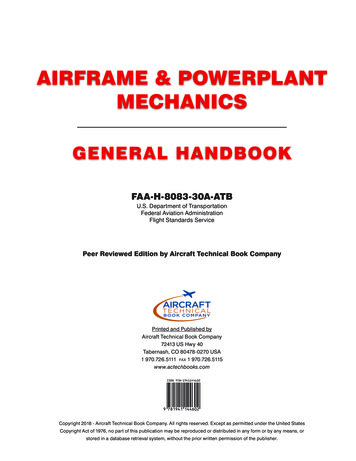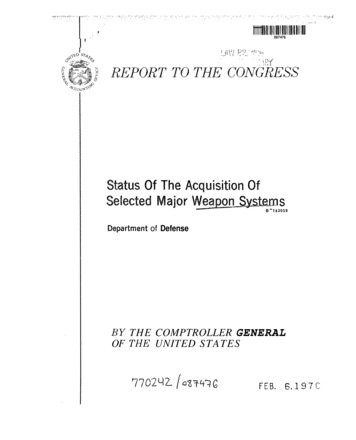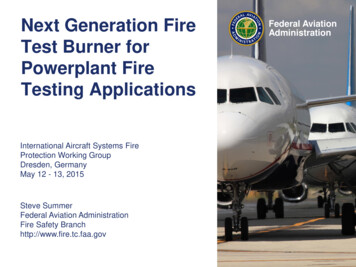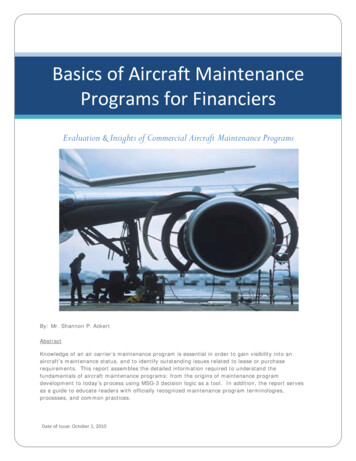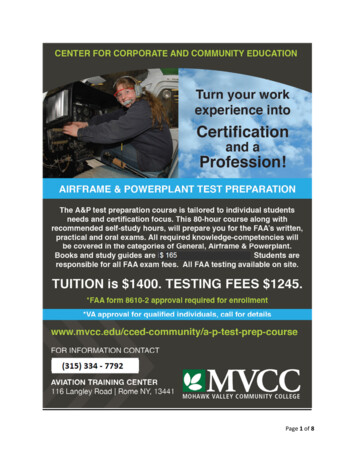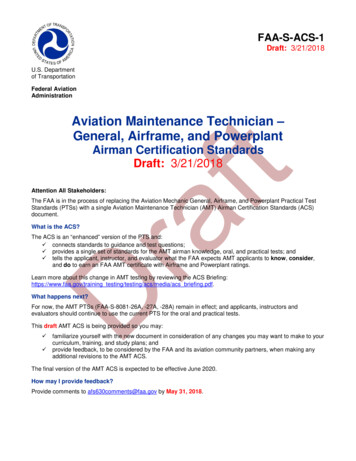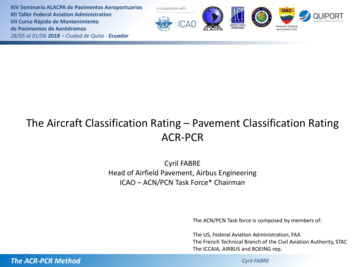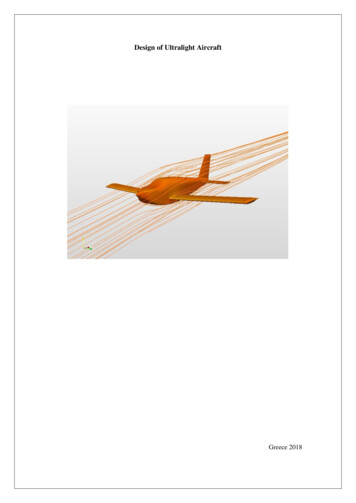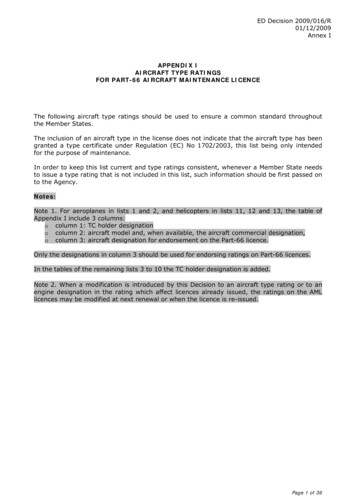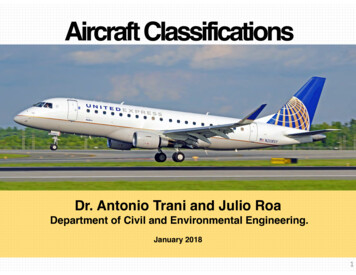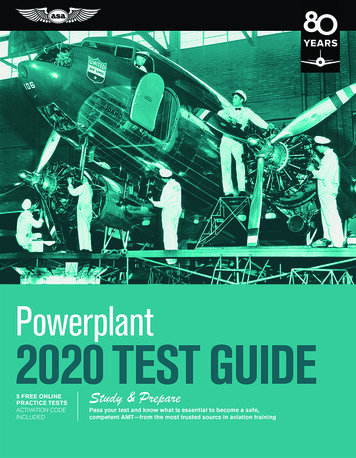
Transcription
Powerplant2020 TEST GUIDEStudy & PreparePass your test and know what is essential to become a safe,competent AMT — from the most trusted source in aviation trainingREADER TIPThe FAA Knowledge Exam Questions can change throughout the year.Stay current with test changes; sign up for ASA’s free email update serviceat asa2fly.com/testupdateAVIATION SUPPLIES & ACADEMICSNEWCASTLE, WASHINGTON
Powerplant Test Guide2020 EditionAviation Supplies & Academics, Inc.7005 132nd Place SENewcastle, Washington 98059-3153425.235.1500 asa2fly.com 2019 Aviation Supplies & Academics, Inc.All rights reserved. No part of the explanations to the FAAquestions may be reproduced in any manner whatsoeverwithout written permission of the publisher.FAA questions herein are from United States governmentsources and contain current information as of: June 2019None of the material in this publication supersedes anydocuments, procedures or regulations issued by the Federal Aviation Administration.ASA assumes no responsibility for any errors oromissions. Neither is any liability assumed for damagesresulting from the use of the information contained herein.Cover photo: Everett Collection Historical/Alamy StockPhoto/Everett CollectionASA-AMP-20-PDPDF eBook ISBN 978-1-61954-795-7Print Book ISBN 978-1-61954-794-0Stay informed of aviationindustry facebook.com/asa2flylearntoflyblog.comPowerplant Test GuideFast-Track Series
ContentsUpdates and Practice Tests. vPreface. viiInstructions. ixLearning Statement Codes. xvKnowledge Exam References. xixPowerplant Test Questions, Explanations, Answers and References. 1Reciprocating Engines. 3Turbine Engines. 20Engine Inspection. 36Engine Instrument Systems.41Engine Fire Protection Systems. 49Engine Electrical Systems. 54Lubrication Systems. 65Ignition and Starting Systems. 77Fuel Metering Systems. 97Engine Fuel Systems. 111Induction and Engine Airflow Systems. 116Engine Cooling Systems.122Engine Exhaust and Reverser Systems.126Propellers.130Auxiliary Power Units.146Powerplant Oral & Practical Study Guide.149The Oral and Practical Tests.150Reciprocating Engines.152Turbine Engines.154Engine Inspection.156Engine Instrument Systems.158Engine Fire Protection Systems.160Engine Electrical Systems.162Lubrication Systems.164Ignition and Starting Systems.166Fuel Metering Systems.170Engine Fuel Systems. 174Induction and Engine Airflow Systems.176Engine Cooling Systems.178Engine Exhaust and Reverser Systems.180Propellers.182Turbine Powered Auxiliary Power Unit.184Fast-Track SeriesPowerplant Test GuideASAiii
Updates and Practice TestsFree Test Updates for the One-Year Life Cycle of the BookThe FAA rolls out new tests as needed throughout the year. The FAA exams are “closed tests” which means the exactdatabase of questions is not available to the public. ASA combines more than 60 years of experience with expertise inairman training and certification tests to prepare the most effective test preparation materials available in the industry.You can feel confident you will be prepared for your FAA Knowledge Exam by using the ASA Test Guides. ASApublishes test books each June and keeps abreast of changes to the tests. These changes are then posted on theASA website as a Test Update.Visit the ASA website before taking your test to be certain you have the most current information. While there, signup for ASA’s free email Update service. We will then send you an email notification if there is a change to the test youare preparing for so you can review the Update for revised and/or new test information.www.asa2fly.com/testupdateWe invite your feedback. After you take your official FAA exam, let us know how you did. Were you prepared? Did theASA products meet your needs and exceed your expectations? We want to continue to improve these products toensure applicants are prepared, and become safe aviators. Send feedback to: cfi@asa2fly.comwww.prepware.comSee inside front coverfor FREE account! Realistic Test SimulationTest questions and timeallowed replicate theofficial FAA examHelping you practice for written exams.As the experts in FAA Knowledge Exam preparation, we want you tohave the confidence needed before heading to the testing center,and help eliminate the hassle and expense of retaking exams. Performance GraphsReview how you did, trackyour performance andreview explanations for thequestions you missed Gain ConfidenceGo into your exam fullyprepared after practicingup to 5 simulated tests SucceedPass your exam,achieve your goals,and set new onesRemote Pilot Sport Pilot Private Pilot Instrument Rating Commercial Pilot Flight Instructor Ground InstructorFundamentals of Instructing Flight Engineer Airline Transport Pilot AMT General Airframe PowerplantPractice tests are also available as an app! www.asa2fly.com/appsFast-Track SeriesPowerplant Test GuideASAv
PrefaceWelcome to ASA’s Test Guide Series, based on the original “Fast-Track” series written by Dale Crane. ASA’s testbooks have been helping Aviation Maintenance Technicians (AMTs) prepare for the FAA Knowledge Exams for morethan 60 years with great success. We are confident with the proper use of this book, you will score very well on yourFAA Knowledge Exam.The ASA “Fast-Track” Test Guide has proven to be the most effective way to study for an FAA A&P KnowledgeTest. This method turns a multiple-choice examination into a study aid, helping you learn the material in the shortestpossible time and learn it in a way that you retain it.The FAA exams are “closed tests” which means the exact database of questions is not available to the public.The question and answer choices in this book are based on our extensive history and experience with the AMT testing process. You might see similar although not exactly the same questions on your official FAA exam. Answer stemsmay be rearranged from the A, B, C order you see in this book. Therefore, be careful to fully understand the intent ofeach question and corresponding answer while studying, rather than memorize the A, B, C answer. You may be askeda question that has unfamiliar wording; studying and understanding the information in this book and the associatedreferences will give you the tools to answer all types of questions with confidence.Begin your studies with a classroom or home-study ground school course, which will involve reading a comprehensive AMT textbook. Conclude your studies with this Test Guide. Read the question, select your choice for the correctanswer, then read the explanation. At the bottom of the page you will find the correct answer, along with the LearningStatement Code and reference from which the answer was derived. Use these references if you need further study ofa subject. Upon completion of your studies, take practice tests at www.prepware.com (see inside front cover for yourfree account).It is important to answer every question assigned on your FAA Knowledge Test. If in their ongoing review, the FAAtest authors decide a question has no correct answer, is no longer applicable, or is otherwise defective, your answerwill be marked correct no matter which one you choose. However, you will not be given the automatic credit unlessyou have marked an answer. Unlike some other exams you may have taken, there is no penalty for “guessing” inthis instance.The ASA Test Guides include, as an important extra feature, typical oral test questions and typical practical projects. These will give you an idea of the questions you will be asked orally, and the projects you will be assigned todemonstrate your skills and reasoning.If your study leads you to question an answer choice, we recommend you seek the assistance of a local instructor.We welcome your questions, recommendations or concerns — send them to:Aviation Supplies & Academics, Inc.7005 132nd Place SENewcastle, WA 98059-3153Voice: 425.235.1500Fax: 425.235.0128Email: cfi@asa2fly.comWebsite: www.asa2fly.comThe FAA appreciates testing experience feedback. You can contact the branch responsible for the FAA KnowledgeExams at the following address:Federal Aviation AdministrationAFS-630, Airman Testing Standards BranchPO Box 25082Oklahoma City, OK 73125Email: afs630comments@faa.govFast-Track SeriesPowerplant Test GuideASAvii
Quick-Reference FAA Exam InformationTestCodeAMAAMGAMPTest NameAviation Mechanic —AirframeAviation Mechanic —GeneralAviation Mechanic —PowerplantNumber ofQuestionsMin.AgeAllotted 070Explanation of Requirements, Authorization and RetestingAcceptable Authorization for All Aviation Mechanic Tests1. Original Federal Aviation Administration (FAA) Form 8610-2, Airman Certificate and/or Rating Application.2. Graduates of a Part 147 school, officially affiliated with a testing center, may take the knowledge test upon presenting an appropriate graduation certificate or certificate of completion to the affiliated testing center. A graduate’sname must be on the certified list received from the Part 147 school prior to administering the appropriate test(s).3. Failed, passing or expired Airman Knowledge Test Report, provided the applicant still has the original test reportin his/her possession. (See Retesting explanation.)Retesting for AMA, AMG, and AMPRetests do not require a 30-day waiting period if the applicant presents a signed statement from an airman holdingthe certificate and rating sought by the applicant. This statement must certify that the airman has given the applicantadditional instruction in each of the subjects failed, and that the airman considers the applicant ready for retesting. A30-day waiting period is required for retesting if the applicant presents a failed airman knowledge test report, but noauthorized instructor endorsement.Applicants taking retests after failure are required to submit the applicable test report indicating failure to the testingcenter prior to retesting. The original failed test report shall be retained by the proctor and attached to the applicablesign-in/out log. The latest test taken will reflect the official score.Applicants retesting in an attempt to achieve a higher passing score may retake the same test for a bettergrade after 30 days. The latest test taken will reflect the official score. Applicants are required to submit the originalapplicable test report indicating previous passing score to the testing center prior to testing. Testing center personnelmust collect and destroy this report prior to issuing the new test report.Note: The testing centers require a wait period of 24 hours before any applicant may retest.viiiASAPowerplant Test GuideFast-Track Series
Learning Statement CodesThe expression “learning statement,” as used in FAA airman testing, refers to measurable statements about theknowledge a student should be able to demonstrate following a certain segment of training. In order that each learningstatement may be read and understood in context as a complete sentence, precede each statement with the words:“Upon the successful completion of training the student should be able to ”— complete the phrase with the subjectindicated by the learning statement code (LSC) given in your knowledge test results.When you take the applicable airman knowledge test required for an airman pilot certificate or rating, you willreceive an Airman Knowledge Test Report. The test report will list the learning statement codes for questions you haveanswered incorrectly. Match the codes given on your test report to the ones in the official FAA Learning StatementCodes (listed below). Your instructor is required to provide instruction on each of the areas of deficiency listed onyour Airman Knowledge Test Report and to give you an endorsement for this instruction. The Airman Knowledge TestReport must be presented to the examiner conducting your practical test. During the oral portion of the practical test,the examiner is required to evaluate the noted areas of deficiency.FAA Learning Statement Codes are prefixed with a letter-identifier (for example, AMP031). For the purposes ofreference within this ASA Test Guide, the letter prefix is omitted; therefore throughout this book, LSCs are referred toby their number-identifiers only, in parentheses.The FAA appreciates testing experience feedback. You can contact the branch responsible for the FAA KnowledgeExams directly at:Federal Aviation AdministrationAFS-630, Airman Testing Standards BranchPO Box 25082Oklahoma City, OK 73125Email: 013AMP014AMP015Subject areaRecall aircraft alternators — components/operating principles/characteristicsRecall aircraft batteries — Recall aircraft carburetor — icing/anti-icingRecall aircraft component markingsRecall aircraft cooling system — components/operating principles/characteristicsRecall aircraft electrical system — install/inspect/repair/serviceRecall aircraft engine — inspections/cleaningRecall aircraft engines — components/operating principles/characteristicsRecall aircraft engines — indicating systemRecall aircraft fire classificationsRecall aircraft hydraulic systems — components/operating principles/characteristicsRecall aircraft instruments — types/components/operating principles/characteristics/markingsRecall airflow systems — Bellmouth compressor inletRecall airframe — inspectionsRecall altitude compensator/aneroid valveContinuedFast-Track SeriesPowerplant Test GuideASAxv
MP057xviASASubject areaRecall anti-icing/deicing — methods/systemsRecall Auxiliary Power Units — components/operating principles/characteristicsRecall Auxiliary Power Units — install/inspect/repair/serviceRecall axial flow compressor — components/operating principles/characteristicsRecall basic physics — matter/energy/gasRecall carburetor — effects of carburetor heat/heat controlRecall carburetors — components/operating principles/characteristicsRecall carburetors — install/inspect/repair/serviceRecall data — approvedRecall DC electric motors — components/operating principles/characteristicsRecall electrical system — components/operating principles/characteristicsRecall engine cooling system — components/operating principles/characteristicsRecall engine cooling system — install/inspect/repair/serviceRecall engine lubricating oils — function/grades/viscosity/typesRecall engine lubricating system — components/operating principles/characteristicsRecall engine lubricating system — install/inspect/repair/serviceRecall engine operations — thrust/thrust reverserRecall engine pressure ratio — EPRRecall fire detection system — types/components/operating principles/characteristicsRecall fire detection systems — install/inspect/repair/serviceRecall fire extinguishing systems — components/operating principles/characteristicsRecall float type carburetor — components/operating principles/characteristicsRecall float type carburetor — install/inspect/repair/serviceRecall fuel — ing/dumpingRecall fuel/oil — anti-icing/deicingRecall fuel system — components/operating principles/characteristicsRecall fuel system — install/troubleshoot/service/repairRecall fuel system — typesRecall generator system — components/operating principles/characteristicsRecall information on an Airworthiness DirectiveRecall magneto — components/operating principles/characteristicsRecall magneto — install/inspect/repair/serviceRecall maintenance publications — service/parts/repairRecall piston assembly — components/operating principles/characteristicsRecall powerplant design — structures/componentsRecall pressure type carburetor — components/operating principles/characteristicsRecall propeller system — install/inspect/repair/serviceRecall propeller system — types/ components/operating principles/characteristicsRecall radial engine — components/operating principles/characteristicsRecall radial engine — install/inspect/repair/serviceRecall reciprocating engine — components/operating principles/characteristicsRecall reciprocating engine — install/inspect/repair/servicePowerplant Test GuideFast-Track Series
ubject areaRecall regulations — maintenance reports/records/entriesRecall regulations — privileges/limitations of maintenance certificates/licensesRecall regulations — privileges of approved maintenance organizationsRecall rotor system — components/operating principles/characteristicsRecall sea level — standard temperature/pressureRecall starter/ignition system — components/operating principles/characteristicsRecall starter/ignition system — install/inspect/repair/serviceRecall starter system — starting proceduresRecall thermocouples — components/operating principles/characteristicsRecall thermocouples — install/inspect/repair/serviceRecall turbine engines — components/operational characteristics/associated instrumentsRecall turbine engines — install/inspect/repair/service/hazardsRecall turbocharger system — components/operating principles/characteristicsRecall turbojet — components/operating principles/characteristicsRecall type certificate data sheet (TCDS)/supplemental type certificate (STC)Recall welding types/techniques/equipmentFast-Track SeriesPowerplant Test GuideASAxvii
Knowledge Exam ReferencesThe FAA references the following documents to write the FAA Knowledge Exam questions. You should be familiar withall of these as part of your classroom studies, which you should complete before starting test preparation:FAA-H-8083-30General Handbook (FAA)FAA-H-8083-31, Vol. 1 & 2 Airframe Handbook (FAA)FAA-H-8083-32, Vol. 1 & 2 Powerplant Handbook (FAA)FAA-H-8083-3Airplane Flying Handbook (FAA)FAA-G-8082-11Inspection Authorization Test Guide (FAA)FAA-G-8082-3Aviation Maintenance Technician Test Guide (FAA)14 CFR Parts 1, 3, 21, 23, 39, 43, 45, 47, 65, 91, 147Advisory Circulars (AC) 21-12, 23-21, 23.1309-1, 43.9-1, 43.13-1Additional resources helpful for AMT studies:AMT-GAviation Maintenance Technician Series General (ASA)AMT-SYSAviation Maintenance Technician Series Airframe, Volume 2: Systems (ASA)AMT-STRUCAMT-PDATAIMAviation Maintenance Technician Series Airframe, Volume 1: Structures (ASA)Aviation Maintenance Technician Series Powerplant (ASA)Dictionary of Aeronautical Terms (ASA)Aeronautical Information Manual (FAA)Fast-Track SeriesPowerplant Test GuideASAxix
Powerplant TestQuestions, Explanations,Answers and ReferencesAnswers are printed at the bottom of the page, with other coded items as explained below:This is the question number.The brackets enclose the letter answer selected byASA’s researchers. (For those questions for whichnone of the answer choices provide an accurateresponse, we have noted [X] as the Answer.)8002 [C] (056)AMT-P Ch 2The parentheses enclose the appropriateLearning Statement Code (LSC)—refer toPage xv. FAA Learning Statement Codeshave letter-identifying prefixes, but forreference purposes in this book the letterprefix (“AMP”) is omitted and only thenumber-identifying portion of the code isshown in parentheses.Fast-Track SeriesThe reference following the Learning StatementCode is the source from which the answer wasderived. The meanings of these abbreviationsare found on Page xix. The number followingthe abbreviations is the specific chapter withinthat source to study for more information aboutthe derived answer.Powerplant Test GuideASA1
Reciprocating EnginesReciprocating Engines8001. Which statement is true regarding bearings used8004. What is the principal advantage of using propellerA— The outer race of a single-row, self-aligning ballbearing will always have a radius equal to theradius of the balls.B— There is less rolling friction when ball bearings areused than when roller bearings are employed.C— Crankshaft bearings are generally of the ball-typedue to their ability to withstand extreme loadswithout overheating.A— To enable the propeller RPM to be increasedwithout an accompanying increase in engine RPM.B— To enable the engine RPM to be increased withan accompanying increase in power and allow thepropeller to remain at a lower, more efficient RPM.C— To enable the engine RPM to be increased with anaccompanying increase in propeller RPM.in high-powered reciprocating aircraft engines?The smaller contact area of a ball bearing causes it toproduce less rolling friction than a roller bearing.Ball bearings are used in high-powered reciprocatingengines, where keeping friction to a minimum is important.Ball bearings can be designed and installed in such away that they reduce friction in axial loads as well as inradial loads.8002. A condition that can occur in radial engines but isunlikely to occur in horizontally opposed engines isA— oil-fouled spark plug.B— valve overlap.C— hydraulic lock.reduction gears?The horsepower produced by a reciprocating engine isdetermined by its RPM. The higher the RPM, the greaterthe power. But the efficiency of a propeller decreases asthe blade tip speed approaches the speed of sound.In order to get the best of both conditions, many of themore powerful aircraft engines drive the propeller througha set of reduction gears.Reduction gears allow the engine to turn fast enough todevelop the required power. At the same time, the propellertip speed is kept low enough that the tips do not approachthe speed of sound.8005. Which of the following will decrease volumetricefficiency in a reciprocating engine?Radial and inverted engines have some cylinders belowthe crankcase, and when the engine is idle, oil will leakfrom the crankcase, past the piston rings, and fill the combustion chamber. This condition is called a hydraulic lock.If this oil is not removed before the engine is started,the piston will move against the noncompressible oil andcause serious damage.8003. Which condition would be the least likely to becaused by failed or failing engine bearings?A— Excessive oil consumption.B— High oil temperatures.C— Low oil temperatures.All of the alternatives except low oil temperature wouldlikely be caused by failed or failing engine bearings in areciprocating engine.Low oil temperature would be the least likely of thesealternatives.1. Full throttle operation.2. Low cylinder head temperatures.3. Improper valve timing.4. Sharp bends in the induction system.5. High carburetor air temperatures.A— 2, 4, and 5.B— 1, 2, 3, and 4.C— 3, 4, and 5.The volumetric efficiency of a reciprocating engine is theratio of the weight of the fuel-air charge taken into thecylinder, to the weight of a charge that would completelyfill the entire volume of the cylinder at the same pressure.Anything that decreases the weight of the air enteringthe cylinder decreases the volumetric efficiency. Impropervalve timing, sharp bends in the induction system, and highcarburetor air temperature will all decrease the volumetricefficiency.Answers Note: All Learning Statement Codes (in parentheses) are preceded by “AMP.” See explanation on Page 1.8001 [B] (056) AMT-P8002 [C] (054) AMT-P Ch 28003 [C] (056) AMT-P8005 [C] (056) AMT-P Ch 2Fast-Track Series8004 [B] (053) AMT-P Ch 2Powerplant Test GuideASA3
Questions, Explanations, Answers & References8006. Which of the following is a characteristic of a thrustbearing used in most radial engines?A— Tapered roller.B— Double-row ball.C— Deep-groove ball.Deep-groove ball bearings are used as the thrust bearingin most radial engines. This type of bearing is the best ofthose listed for reducing friction while carrying both thrustand radial loads.Area 0.7854 bore 2 0.7854 30.25 23.75 square inchesVolume piston area stroke 23.75 6 142.55 cubic inchesPiston displacement volume number of cylinders 142.55 9 1,282.95 cubic inches8007. Which bearing is least likely to be a roller or ball8010. The five events of a four-stroke cycle engine in theA— Rocker arm bearing (overhead valve engine).B— Master rod bearing (radial engine).C— Crankshaft main bearing (radial engine).A— intake, ignition, compression, power, and exhaust.B— intake, compression, power, ignition, and exhaust.C— intake, compression, ignition, power, and exhaust.The master rod bearing in a radial engine is always aplain bearing.Rocker arm bearings may be either ball, roller, or plaintype and the crankshaft main bearings for radial enginesare usually ball bearings.The five events that take place in a reciprocating engineduring each cycle of its operation are:bearing?8008. The operating temperature valve clearance of aradial engine as compared to cold valve clearance isA— greater.B— less.C— the same.When a radial engine is operating, the cast aluminum alloycylinder head expands far more than the steel push rod.As the cylinder head expands, the rocker arm moves awayfrom the cam ring and the hot, or running, valve clearancebecomes much greater than the cold clearance.8009. A nine-cylinder engine with a bore of 5.5 inches anda stroke of 6 inches will have a total piston displacement ofA— 740 cubic inches.B— 1,425 cubic inches.C— 1,283 cubic inches.The piston displacement of a reciprocating engine is thetotal volume swept by the pistons in one revolution of thecrankshaft.Find the piston displacement of one cylinder by multiplying the area of the piston in square inches by the stroke,which is measured in inches.The total piston displacement is the volume of one cylinder, measured in cubic inches, multiplied by the numberof cylinders.Answers8006 [C] (056) AMT-P Ch 28010 [C] (056) AMT-P Ch 24ASA8007 [B] (054) AMT-P8011 [A] (056) AMT-P Ch 2Powerplant Test Guideorder of their occurrence areIntake — The fuel-air mixture is taken into the cylinder.Compression — The fu
AMA Aviation Mechanic—Airframe 100 N/A 2.0 70 AMG Aviation Mechanic—General 60 N/A 2.0 70 AMP Aviation Mechanic—Powerplant 100 N/A 2.0 70 Explanation of Requirements, Authorization and Retesting Acceptable Authorization for All Aviation Mechanic Tests 1. Original Federal Aviation Administration (FAA) Form 8610-2, Airman Certificate and/or .

